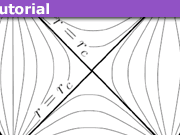Slowly Lowering an Object in a Static, Spherically Symmetric Spacetime
In the first two articles in this series, we looked at the Einstein Field Equation and Maxwell’s Equations in a static, spherically symmetric spacetime. Using formulas from those two previous articles, I now want to consider the question: what is the maximum amount of work that can be extracted by slowly lowering an object into a static, spherically symmetric gravitational field? This is a concrete, physical way of defining the concept of “potential energy”. (We’ll come back to the concept of “potential energy” and its relationship to other concepts of energy at the end of this article.)
We start with some comments and definitions. By “slowly lowering” we mean that the radial motion of the object is at some very slow, constant speed so that we can ignore its effect on the dynamics. That is, for purposes of this problem, we treat the object as passing through a succession of static states, each at a slightly different radius. So at a given instant, we assume that the 4-velocity of the object has only one significant non-zero component, [itex]u^t = 1 / \sqrt{J}[/itex], the time component. (Remember that [itex]J(r)[/itex] is the function of radius that appears in the [itex]g_{tt}[/itex] metric coefficient.) This assumption greatly simplifies the math.
We can then write the object’s instantaneous proper acceleration at radius r as follows:
[tex]a(r) = \sqrt{g_{rr}} \Gamma^r{}_{tt} \left( u^t \right)^2[/tex]
Using formulas from previous posts, this becomes
[tex]a(r) = \sqrt{\frac{r}{r – 2m}} \frac{r – 2m}{r} \frac{1}{2J} \frac{dJ}{dr} = \sqrt{\frac{r – 2m}{r}} \frac{m + 4 \pi r^3 p}{r \left( r – 2m \right)} = \frac{m + 4 \pi r^3 p}{r^2 \sqrt{1 – 2m / r}}[/tex]
We now use the fact that [itex]dm / dr = 4 \pi r^2 \rho[/itex] to rewrite the above as
[tex]a(r) = \frac{m – r ( dm / dr )}{r^2 \sqrt{1 – 2m / r}} + \frac{4 \pi r \left( \rho + p \right)}{\sqrt{1 – 2m / r}}[/tex]
We note in passing that, in the vacuum region outside a spherically symmetric uncharged gravitating body, [itex]dm / dr[/itex], [itex]\rho[/itex], and [itex]p[/itex] are all zero, so this reduces to the usual formula for the proper acceleration of a “hovering” observer.
Now, the work per unit mass [itex]\mu[/itex] (more precisely, [itex]\mu[/itex] is the “rest mass at infinity” of the object) that can be extracted by slowly lowering an object from infinity to radius [itex]R[/itex], provided that the object has no non-gravitational forces acting on it (see below for more on that qualification), is given by
[tex]\frac{W}{\mu} = \int_R^{\infty} a(r) dr = \int_R^{\infty} \left( \frac{m – r ( dm / dr )}{r^2 \sqrt{1 – 2m / r}} + \frac{4 \pi r \left( \rho + p \right)}{\sqrt{1 – 2m / r}} \right) dr[/tex]
The first term is a total derivative and so is trivial to integrate; this gives
[tex]\frac{W}{\mu} = 1 – \sqrt{1 – \frac{2m(R)}{R}} + \int_R^{\infty} \frac{4 \pi r \left( \rho + p \right)}{\sqrt{1 – 2m / r}} dr[/tex]
The first two terms tell us that the closer we lower the object to the point where [itex]R = 2m(R)[/itex], the more of its rest mass at infinity we can extract as work; in the limit if we look at only the first two terms, we can extract all of the object’s rest mass at infinity as we lower it (of course any real process will have to fall short of that limit by some amount). The third term is interesting, but before discussing that, let’s cover the important special case where the third term is identically zero so that the first two terms are the entire answer. This can happen in one of two ways:
(1) A vacuum spacetime: the SET is zero everywhere, so [itex]\rho[/itex] and [itex]p[/itex] are both zero. An example is a standard Schwarzschild black hole.
(2) A spacetime where the SET is such that [itex]p = – \rho[/itex]. The most obvious case of this, as mentioned in previous posts, is the case of a static, spherically symmetric electric field, such as in Reissner-Nordstrom spacetime. Obviously in this case the third term is zero.
However, the second case also brings up the possibility of a non-gravitational force (electromagnetic, in the Reissner-Nordstrom case) acting on an object. In such cases, we have to add a term to the integral to represent the interaction energy due to the non-gravitational force. In general, this could be anything, but in the case where we restrict everything to be static and spherically symmetric, we can always describe the interaction energy as a function [itex]U(r)[/itex], such that the extra integrand looks like this:
[tex]\bar{a}(r) = \sqrt{g_{rr}} \nabla^r U(r) = \sqrt{g_{rr}} \sqrt{g^{rr}} \frac{dU}{dr} dr = dU[/tex]
Obviously, this can simply be integrated to give the value of U at the endpoints; but if U is scaled to go to zero in the limit as r goes to infinity, then we simply have [itex]- U(R)[/itex] as the extra term due to the interaction energy, for a final answer of
[tex]\frac{W}{\mu} = 1 – \sqrt{1 – \frac{2m(R)}{R}} – U(R) + \int_R^{\infty} \frac{4 \pi r \left( \rho + p \right)}{\sqrt{1 – 2m / r}} dr[/tex]
Note the sign of the U term; a positive U, such as from like charges repelling, decreases the work that can be extracted by lowering the object, while a negative U, such as from unlike charges attracting, increases the work. This makes sense and provides a useful sanity check.
We can now write down two obvious cases that are often of interest. The first is slowly lowering an object in Schwarzschild spacetime. For this case, ##m(r)## is a constant, ##M##, and ##U(r)## is zero since there are no non-gravitational forces acting, so we have
$$
\frac{W}{\mu} = 1 – \sqrt{1 – \frac{2M}{R}}
$$
For the common case where ##R >> M##, we have ##W / \mu = M / R##, which should be recognizable as the Newtonian formula for potential energy per unit mass (remember that we are using “natural” units in which ##G = c = 1##).
The second case is slowly lowering an object with charge ##q## in Reissner-Nordstrom spacetime. Here ##m(r) = M – Q^2 / 2r##, and ##U(r) = q Q / r##, so we have
$$
\frac{W}{\mu} = 1 – \sqrt{1 – \frac{2M}{R} + \frac{Q^2}{R^2}} – q Q / R^2
$$
And again, for the common case where ##R >> M > Q##, we have
$$
\frac{W}{\mu} = \frac{M}{R} – \frac{Q \left( Q + 2 q \right)}{2R^2}
$$
Note that here this approximation does not give exactly the non-relativistic approximation; the extra factor of ##Q^2 / 2 R^2## shows up at the same order as the standard Coulomb potential energy. Or, to put it another way, a neutral object lowered into a charged black hole will yield less work per unit mass than the same object lowered into an uncharged (Schwarzschild) black hole of the same mass. The difference is the radial tension in the electromagnetic field, which can be thought of, heuristically, as exerting some “gravitational repulsion” that pushes the object outward and reduces the work that can be extracted.
Now let’s go back and look at the last term in the general formula for ##W / \mu##, the one with the integral. This term will be nonzero if the object is being lowered through the interior of a gravitating body made of something with ##\rho + p \neq 0##, which will be true for an object made of ordinary matter. For example, it will be nonzero for an object being lowered into, say, the ocean on Earth. What is interesting about this term is that for something like ordinary matter, for which ##\rho + p > 0##, this term is positive; in other words, it increases the work that can be extracted! This seems highly counterintuitive: it seems like lowering an object through the ocean on Earth should yield less work than lowering the same object the same distance through air (let alone through a vacuum).
Remember, though, that there is also the ##U(R)## term due to non-gravitational interactions, and for a case like lowering an object through the ocean, this term will be negative (it will reduce the work that can be extracted), and will typically be much, much larger than the integral term, because in “natural” units quantities like ##\rho## and ##p## are very, very small. Why? Because of the factor ##G / c^2## that converts stress-energy from conventional units to natural units, which is something like ##10^{-27}##. So the integral term is really a correction to the ordinary non-relativistic formula involving forces like buoyancy that come into play when lowering objects through fluids, and this correction will be tiny in any ordinary case.
As a final note, let’s go back to the concept of “potential energy” that was mentioned at the start of this article. In a static spacetime, a test object will have a property called “energy at infinity” due to the presence of a timelike Killing vector field. The general formula for this is ##E = g_{ab} p^a \xi^b##, where ##p^a## is the object’s 4-momentum and ##\xi^b## is the Killing vector. To put this in “per unit mass” terms we can divide by the rest mass ##\mu## of the test object to get ##E / \mu = g_{ab} u^a \xi^b##, where ##u^a## is the object’s 4-velocity vector.
Now consider the energy at infinity of a static observer. This is an observer whose 4-velocity is ##\sqrt{J} \xi^a##, where ##J(r)## is the function that appears in the ##g_{tt}## metric coefficient. We therefore have ##E / \mu = \sqrt{J} g_{ab} \xi^a \xi^b##. But it can be shown that ##g_{tt} = – 1 / \sqrt{g_{ab} \xi^a \xi^b}## for any static spacetime in the coordinates we are using. Therefore we have
$$
\frac{E}{\mu} = \sqrt{g_{ab} \xi^a \xi^b}
$$
for a static observer.
We now bring in another key fact: energy at infinity is a constant of geodesic motion in a static spacetime. That means that, for the case where the spacetime is a vacuum in the region our slowly lowered object traverses, we can make the following observations: start with two identical test objects at rest at infinity. It should be obvious that ##E / \mu = 1## for these objects. (If it isn’t obvious, consider that in the coordinates we are using, we have ##\xi^a = \left( 1, 0, 0, 0 \right)##, and think about what value ##g_{tt}## takes at infinity.) Take one object and slowly lower it through Schwarzschild vacuum to radius ##R##, extracting work ##W / \mu## according to the above formula for this case. Take the other and let it free fall to radius ##R##, and then bring it to rest thereby extracting all its kinetic energy and transmitting it back up to infinity, and storing it there.
Our two objects are now once again in the same state, this time at rest at radius ##R##. Their energy at infinity is therefore once again the same. What is it? Well, they traversed Schwarzschild vacuum, so we have ##E / \mu = \sqrt{g_{tt}}## (since, as above, ##\xi^a = \left( 1, 0, 0, 0 \right)##), and therefore
$$
\frac{E}{\mu} = \sqrt{1 – \frac{2M}{R}}
$$
Looking at the formula for ##W / \mu## above for this case, we can see that
$$
\frac{E}{\mu} = 1 – \frac{W}{\mu} = \left( \frac{E}{\mu} \right)_{\infty} – \frac{W}{\mu}
$$
In other words, the work extracted from the slowly lowered object is equal to its change in energy at infinity. But for the free-falling object, its energy at infinity was constant during its fall, so the kinetic energy that had to be extracted from it to bring it to rest must be equal to the work extracted from the slowly lowered object (note that we have to evaluate this equality at infinity because that is where the extracted work and the transmitted kinetic energy are stored).
What all this suggests is that the energy at infinity of a general test object in a static spacetime can be split into two pieces: the energy at infinity of a static object at the same radius ##R##, which can be thought of as the object’s potential energy, and the rest, which can be thought of as the object’s kinetic energy (since it is its kinetic energy relative to a static observer at the same radius, as evaluated at infinity). But notice that on this interpretation, the rest mass of the object is part of its potential energy. At infinity, an object at rest has only potential energy, and it is equal to its rest mass. At a finite radius ##R##, an object at rest has smaller potential energy, which can be interpreted as its rest mass combined with the usual (negative) potential energy, which in the Newtonian approximation is just ##- M / R##.
The more general formula for ##W / \mu## can then be thought of as generalizing the same idea as above to the case where the spacetime is not a vacuum and non-gravitational forces may be present. The extra terms in ##W / \mu## account for the fact that ##J## is not equal to ##1 – 2M / r##; if you dig into the details (using the formulas from previous posts), you will see that this ultimately comes from the connection between ##J## and ##p##.
- Completed Educational Background: MIT Master’s
- Favorite Area of Science: Relativity










Leave a Reply
Want to join the discussion?Feel free to contribute!